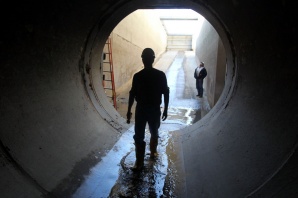

|
This is where the Tempe Canal ends over by Mesa Community College
just south of Southern.
I didn't know it but this secret canal goes from there to the
Western Canal near Guadalupe Road and the Price Freeway..
SRP takes on dirty job of inspecting canals by Weldon B. Johnson - Dec. 27, 2011 09:44 PM The Arizona Republic If you enjoy being in confined, dank, dark spaces, ankle-deep in muck while feeling the crunch of clams and mussels underfoot, Salt River Project has the perfect job for you. Every other winter, when SRP drains its canals for maintenance and cleanup, workers have the dark and foreboding job of inspecting the Tempe Twin Pipes structure. The pipes are two, 10-foot-wide tunnels that carry canal water under the Price and Superstition freeways. Just like the canals, they need to be cleaned and inspected regularly. The parallel tunnels wind for 2½ miles underground, starting just south of Banner Desert Medical Center near Southern Avenue and Dobson Road in Mesa and ending up at the Western Canal near Guadalupe Road and the Price Freeway. One tunnel is shut down at a time, with each getting a thorough inspection every four years. "We just go through and look for cracks, and if anything is stuck in there, which is kind of unusual, we remove it," SRP trades helper Scott Downey said. "We haven't found anything scary down there, at least not while I've been in there." Although there have been strange things found in the canals, such as cars and, occasionally, bodies, that's not the case in the tunnels. That's mainly because there are narrowly spaced grates on either end of the tunnels to keep trash out. The tunnels themselves can be sufficiently scary, however. It doesn't take long to lose sight of daylight within the tunnels. Without the flashlights and other artificial lights the workers carry, they would quickly be enveloped in darkness. Although the grates on either end keep out larger debris and fish, smaller fish can make their way into the tunnels and grow large enough that they can't get out. During cleanup and inspection, the fish that don't get flushed when the tunnel is pumped out are trapped. They try to find sufficient water among the mud and muck left on the tunnel floor to survive. The noise they make sounds eerily like rushing water. "And it can be a little creepy to have fish flopping around your ankles," Downey said. Of bigger concern are poisonous or explosive gases. "We carry (electronic) sniffers while we're down there," foreman Barry Kropp said. "They check the air for enough oxygen, carbon monoxide, methane, carbon particulates, hydrocarbons, hydrogen sulfides. The parameters are built in to that, so the alarm goes off before you're in danger. It gives you a buffer of time to get out." Those who work inside the tunnels carry an air horn to signal emergencies. "If anybody blows that horn, it's time to get out," Downey said. "Or if one of the air sniffers goes off. You don't wait around to find out what's going on, you just get out." Reach the reporter at weldon.johnson@arizonarepublic.com or 602-444-7801. |